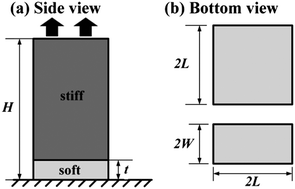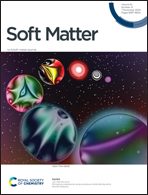Adhesion of flat-ended pillars with non-circular contacts†
Abstract
Fibrillar adhesives composed of fibers with non-circular cross-sections and contacts, including squares and rectangles, offer advantages that include a larger real contact area when arranged in arrays and simplicity in fabrication. However, they typically have a lower adhesion strength compared to circular pillars due to a stress concentration at the corner of the non-circular contact. We investigate the adhesion of composite pillars with circular, square and rectangular cross-sections each consisting of a stiff pillar terminated by a thin compliant layer at the tip. Finite element mechanics modeling is used to assess differences in the stress distribution at the interface for the different geometries and the adhesion strength of different shape pillars is measured in experiments. The composite fibrillar structure results in a favorable stress distribution on the adhered interface that shifts the crack initiation site away from the edge for all of the cross-sectional contact shapes studied. The highest adhesion strength achieved among the square and rectangular composite pillars with various tip layer thicknesses is approximately 65 kPa. This is comparable to the highest strength measured for circular composite pillars and is about 6.5× higher than the adhesion strength of a homogenous square or rectangular pillar. The results suggest that a composite fibrillar adhesive structure with a local stress concentration at a corner can achieve comparable adhesion strength to a fibrillar structure without such local stress concentrations if the magnitude of the corner stress concentrations are sufficiently small such that failure does not initiate near the corners, and the magnitude of the peak interface stress away from the edge and the tip layer thickness are comparable.



 Please wait while we load your content...
Please wait while we load your content...